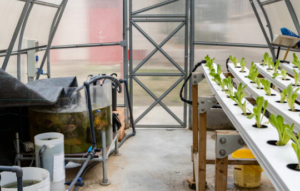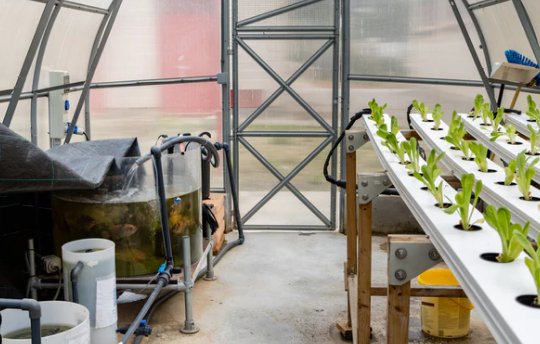Constructing a Self-Sustaining Aquaponics System
An aquaponics system integrates aquaculture (fish farming) and hydroponics (soilless plant cultivation) into a self-sustaining cycle. The fish waste provides nutrients for the plants, while the plants purify the water for the fish. This efficient, sustainable setup is ideal for producing food while conserving water and space. Here’s how to build one:
1. Objectives and Goals
- Primary Purpose: Create a sustainable food production system that combines fish and plant farming.
- Key Features:
- Efficient nutrient recycling.
- Minimal water usage.
- Low environmental impact.
- Target Audience: Urban gardeners, small-scale farmers, and sustainability enthusiasts.
2. System Components
A. Aquaculture Tank
- Purpose: Houses fish and serves as the primary water and nutrient source for the system.
- Size: Depends on the scale of the system; for beginners, a 100–200-gallon tank is ideal.
- Material: Food-grade plastic, fiberglass, or metal with a non-toxic liner.
B. Grow Beds
- Purpose: Provides space for plants to grow.
- Medium: Use materials like expanded clay pellets, gravel, or coconut coir to support plant roots.
- Design: Choose between flood-and-drain (ebb and flow), NFT (Nutrient Film Technique), or raft systems.
C. Water Pump
- Purpose: Circulates water between the fish tank and grow beds.
- Specifications: Choose a pump that can handle the required flow rate, typically 200–300 gallons per hour (GPH) for small systems.
D. Air Pump
- Purpose: Oxygenates water for fish and plants.
- Specifications: Select an air pump suitable for the tank volume and include air stones or diffusers.
E. Plumbing and Piping
- Use PVC or food-grade tubing for water flow between components.
- Install valves to control flow rates and maintain balance.
F. Filtration System
- Mechanical Filter: Removes solid waste from the fish tank.
- Biofilter: Converts ammonia (from fish waste) into nitrates using beneficial bacteria.
G. Plants
- Ideal Crops: Leafy greens (lettuce, kale, spinach), herbs (basil, mint, parsley), and some fruiting plants (tomatoes, peppers, strawberries).
- Plant Density: Match the plant-to-fish ratio to maintain nutrient balance.
H. Fish
- Suitable Species: Tilapia, catfish, trout, and ornamental fish like goldfish or koi.
- Stocking Density: Typically, 1 inch of fish per gallon of water for beginners.
3. System Design Options
- Media-Based System: Uses grow beds filled with inert growing media to filter water and support plants.
- Deep Water Culture (DWC): Plants float on rafts in nutrient-rich water.
- NFT (Nutrient Film Technique): A thin film of water flows through channels to nourish plant roots.
4. Steps to Build the System
A. Setup the Aquaculture Tank
- Place the tank in a stable, shaded area to avoid temperature fluctuations.
- Install the air pump with air stones to ensure adequate oxygen levels.
B. Install the Grow Beds
- Position grow beds above or beside the fish tank to utilize gravity for water flow (if desired).
- Fill grow beds with your chosen growth medium.
- Set up an overflow mechanism to prevent flooding.
C. Connect Components
- Use PVC pipes or tubing to connect the fish tank, grow beds, and filtration units.
- Install a water pump to circulate water from the fish tank to the grow beds.
- Add a mechanical filter and biofilter between the fish tank and grow beds.
D. Test the System
- Run the system with clean water to check for leaks, proper flow, and filtration.
- Monitor water temperature, pH (6.8–7.2), and flow rates.
E. Add Fish and Plants
- Start with a small number of fish to allow beneficial bacteria to establish.
- Introduce plants once ammonia and nitrate levels stabilize.
5. Maintenance
- Daily Checks:
- Feed fish in small amounts to prevent overfeeding and water pollution.
- Observe fish behavior for signs of stress or illness.
- Weekly Tasks:
- Test water quality (ammonia, nitrites, nitrates, pH).
- Remove any dead plant material or uneaten fish food.
- Monthly Maintenance:
- Clean mechanical filters and inspect plumbing for clogs or damage.
- Harvest plants as they mature.
6. Sustainability Features
- Water Conservation: Recycles water, requiring only occasional top-ups.
- Nutrient Efficiency: Converts fish waste into plant nutrients, reducing the need for fertilizers.
- Energy Savings: Incorporate solar panels to power pumps and aerators.
7. Cost Estimate
- Small System (~100 gallons):
- Fish tank: $100–$200.
- Grow beds and media: $50–$150.
- Pumps and aeration: $50–$100.
- Filters and plumbing: $50–$100.
- Total: $250–$550 (excluding optional features like solar power).
8. Example Use Case
- Scenario: A backyard aquaponics system producing herbs and fish for a family.
- Solution: A 100-gallon system with tilapia and a grow bed for basil, lettuce, and kale. The family harvests fresh produce weekly and fish every few months.
9. Benefits
- Environmental Impact: Reduces water usage and eliminates harmful agricultural runoff.
- Health: Produces fresh, pesticide-free food.
- Educational Value: Teaches sustainable practices and ecosystem management.
Would you like detailed assistance with specific components, such as fish selection, nutrient management, or system scalability?

Also Read :
